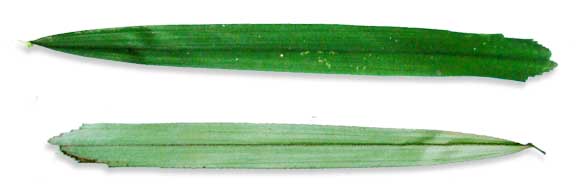|  Gen info Gen info
Arenga tremula subsp. tremula is an ornamental Philippine endemic dwarf sugar palm. The genus comprises 22 species which are good sources of sugar and starch. There are two subspecies of Arenga tremula: Arenga tremula which is endemic in the Philippines, and A. longistamina Mogea which is found in Hainan, Taiwan and Ryuku islands. (2)
Botany
Unlike the kaong, gumayaka is a small,
trunkless palm with thick and adventitious roots. Stems are not long,
but relatively slender and occurring in clumps. Leaves are up to 5 to
8 meters long, spreading, with petioles 1 to 2 meters long, green, channeled
along the base where the edges are fringed with black, ascending bristle like
fibers. The leaflets are linear, varying from 50 to 80 centimeters long and 1.5
to 4 centimeters wide, sometimes partially united at the apex, opposite or in
alternating pairs, subglaucous underneath, the constricted base with
a small lobe, truncate apex finely toothed, the midrib ridged beneath. Peduncles
are about 30 centimeters long and 2.5 centimeters thick. Male flowers are on separate
stalks, about 1 centimeter long, the petals bulging out along valvate sides.
Fruiting spikes are pendulous, longer and more numerous than the male
spikes. Fruit is globose, smooth, thin-skinned, scanty pulp, dark red
when ripe, and usually two-seeded.
Distribution
- In thickets and secondary
forests at low altitudes in Bataan, Batangas, Laguna and Quezon Provinces in Luzon; in Mindoro and Mindanao.
Constituents
- Dichlormethane extract of twigs of Arenga tremula subsp. tremula yielded squalene (1), chlorophyll a (2), monoglycerides (3) and triglycerides (4), while the leaves yielded 2, 4, lutein (5), and a mixture of ß-sitosterol (6) and stigmasterol (7). (see study below) (2)
Properties
- Intoxicant, soporific.

Uses
Edibility
• The ubod is edible.
• Good source of sugar and starch.
Folkloric
• The bud (ubod), eaten in considerable
quantity, is intoxicating followed by long periods of profound sleep.
Others
• Stems provide a strong
and stiff fiber.
• Leaf stalks split for making baskets.
Toxicity
- Young fruit is poisonous and
contains irritating raphides in the pericarp.
Fruit juices can cause skin irritation and blisters.
- Seed reportedly poisonous if ingested.
Studies
• Chemical Constituents / Known Bioactivities of Isolated Compounds: Study of leaves and twigs yielded squalene (1), chlorophyll a (2) monoglycerides (3) and triglycerides (4), while the leaves yielded 2, 4, lutein (5), and a mixture of ß-sitosterol (6) and stigmasterol (7).
Although there are no reported bioactivities for A. tremula, the isolated compounds are known for diverse bioactivities (1) significantly suppresses colonic ACF formation and crypt multiplicity (2) wound healing, anti-inflammatory, chemopreventive (3 and 4) antimicrobial, (5) tumor growth inhibition, (6) growth inhibitory effects on human breast MCF-7 and (7) efficacy against Ehrlich ascites carcinoma, lowers cholesterol, etc. (2)
Availability
Wildcrafted.
Ornamental cultivation. |


 Gen info
Gen info


